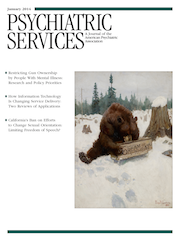Barriers to Implementing Evidence-Based Smoking Cessation Practices in Nine Community Mental Health Sites
Abstract
Objective
Methods
Results
Conclusions
Methods
Study design and sample
Study questionnaire
Analysis
Results
Participant characteristics
Assessment of smoking status
| Question | N of clinicians responding | Response | ||||
|---|---|---|---|---|---|---|
| Assessment and utilization questions | Never | Rarely | Sometimes | Often | Always | |
| Ask about smoking status | 94 | 4 | 14 | 40 | 30 | 12 |
| Ask about interest in quitting | 94 | 5 | 14 | 35 | 32 | 14 |
| Advise to quit smoking | 93 | 4 | 27 | 37 | 23 | 10 |
| Provide brief counseling | 94 | 12 | 23 | 46 | 18 | 1 |
| Give out stop-smoking materials | 92 | 30 | 37 | 22 | 10 | 1 |
| Discuss use of medication | 94 | 25 | 26 | 34 | 14 | 1 |
| Refer to someone for more information | 95 | 38 | 25 | 19 | 17 | 1 |
| Refer to telephone quitline | 93 | 59 | 17 | 14 | 10 | 0 |
| Suggest a follow-up visit | 93 | 48 | 22 | 19 | 11 | 0 |
| Barrier questions | None | Minor | Moderate | Major | ||
| Lack of clinician time | 94 | 15 | 42 | 29 | 14 | |
| Lack of reimbursement | 93 | 31 | 26 | 26 | 17 | |
| Lack of success rate | 94 | 19 | 33 | 29 | 19 | |
| They aren’t interested in quitting | 94 | 7 | 16 | 35 | 42 | |
| No place to refer for help | 94 | 19 | 33 | 36 | 12 | |
| Smokers can’t afford counseling | 94 | 19 | 22 | 31 | 28 | |
| Smokers can’t afford patch or gum | 94 | 8 | 17 | 32 | 43 | |
| Smokers can’t afford bupropion | 92 | 17 | 25 | 34 | 24 | |
| Smokers can’t afford varenicline | 90 | 13 | 26 | 32 | 29 | |
| Resource questions | Never | Rarely | Sometimes | Often | Always | |
| Smoking status preidentified | 95 | 5 | 18 | 27 | 26 | 23 |
| Reminder prompt to advise | 94 | 36 | 27 | 20 | 11 | 6 |
| Stop-smoking handouts | 95 | 30 | 30 | 19 | 14 | 7 |
| Convenient way to refer to classes | 95 | 23 | 25 | 24 | 15 | 13 |
| Convenient way to refer to quitline | 95 | 42 | 33 | 14 | 8 | 3 |
| On-site staff available | 95 | 39 | 20 | 20 | 12 | 9 |
| Confidence question | Not at all | A little bit | Somewhat | A lot | Very | |
| How confident are you in your ability to counsel smokers who are interested in quitting smoking? | 95 | 7 | 24 | 42 | 21 | 5 |
| Knowledge question | Yes | Unsure | No | |||
| Do you think that quitting smoking will worsen psychiatric symptoms? | 95 | 23 | 43 | 34 | ||
Perceived barriers
Availability of smoking cessation resources
Willingness to adopt evidence-based practices
Discussion
Conclusions
Acknowledgments and disclosures
References
Information & Authors
Information
Published In

Cover: A ‘Bear’ Chance, by Philip Russell Goodwin, 1907. Oil on canvas. Minneapolis Institute of Arts, gift of the National Biscuit Company; the Bridgeman Art Library, New York.
History
Authors
Metrics & Citations
Metrics
Citations
Export Citations
If you have the appropriate software installed, you can download article citation data to the citation manager of your choice. Simply select your manager software from the list below and click Download.
For more information or tips please see 'Downloading to a citation manager' in the Help menu.
View Options
View options
PDF/EPUB
View PDF/EPUBLogin options
Already a subscriber? Access your subscription through your login credentials or your institution for full access to this article.
Personal login Institutional Login Open Athens loginNot a subscriber?
PsychiatryOnline subscription options offer access to the DSM-5-TR® library, books, journals, CME, and patient resources. This all-in-one virtual library provides psychiatrists and mental health professionals with key resources for diagnosis, treatment, research, and professional development.
Need more help? PsychiatryOnline Customer Service may be reached by emailing [email protected] or by calling 800-368-5777 (in the U.S.) or 703-907-7322 (outside the U.S.).
